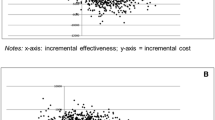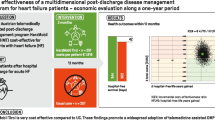Abstract
Background
Since the late 1990s, cost pressure has led to a growing interest in outpatient rehabilitation in Germany where predominantly inpatient rehabilitation has been provided. Taking into account the feasibility of a randomized design, the aim of this study was to compare outpatient and inpatient cardiac rehabilitation from a societal perspective.
Method
A comprehensive cohort design was applied. Costs during rehabilitation were measured using individual documentation of the rehabilitation centers. Economic end points were quality of life (EQ-5D), and total direct and indirect costs. A propensity score approach, integrated into a simultaneous regression framework for cost and effects, was used to control for selection bias. Bootstrap analysis was applied for assessing uncertainty in cost-effectiveness.
Results
A total of 163 patients were included in the study (112 inpatients, 51 outpatients). As randomization was chosen by only 2.5% of participants, the study had to be analyzed as an observational study. Direct costs during inpatient rehabilitation were significantly higher by 600 € (±318; p < 0.001) compared to outpatient rehabilitation (2,016 € ± 354 € vs. 1,416 € ± 315), while there was no significant difference in health-related quality of life. Over the 12-month follow-up period, adjusted costs difference in total cost was estimated at −2,895 € (p = 0.102) and adjusted difference in effects at 0.018 quality-adjusted life years (QALYs) (n.s.) in favor of outpatient treatment.
Conclusion
The ratio of mean cost over mean effect difference (incremental cost-effectiveness ratio) indicates dominance of outpatient rehabilitation, but at a considerable statistical uncertainty. However, outpatient rehabilitation cannot be rejected from an economic perspective.


Similar content being viewed by others
Notes
The model included sociodemographic variables, distance from outpatient rehabilitation center and baseline score of QOL, as additional clinical characteristics showed no improvement of the model.
References
Ades PA, Pashkow FJ, Nestor JR (1997) Cost-effectiveness of cardiac rehabilitation after myocardial infarction. J Cardiopulm Rehabil 17:222–231
Aidelsburger P, Grabein K, Klauss V, Wasem J (2008) Cost-effectiveness of cardiac resynchronization therapy in combination with an implantable cardioverter defibrillator (CRT-D) for the treatment of chronic heart failure from a German health-care system perspective. Clin Res Cardiol 97:89–97
Bjarnason-Wehrens B, Bott D, Benesch L, Bischoff KO, Buran-Kilian B, Gysan D, Hollenstein U, Mayer-Berger W, Wilkniss R, Sauer G (2007) Long-term results of a three-week intensive cardiac outpatient rehabilitation program in motivated patients with low social status. Clin Res Cardiol 96:77–85
British Heart Foundation (2008) BHF Coronary heart disease statistics. http://www.heartstats.org. Accessed 20 Aug 2008
Cook JR, Heyse JF (2000) Use of an angular transformation for ratio estimation in cost-effectiveness analysis. Stat Med 19:2989–3003
D’Agostino RB Jr (2007) Propensity scores in cardiovascular research. Circulation 115:2340–2343
Davison AC, Hinkley DV (1997) Bootstrap methods and their application. Cambridge University Press, NY
Dixon T, Lim LL, Oldridge NB (2002) The MacNew heart disease health-related quality of life instrument: reference data for users. Qual Life Res 11:173–183
Drummond MF, Stoddart GL, Torrance GW (1997) Methods for the economic evaluation of health-care programmes, 2nd edn. Oxford University Press, Oxford
Efron B, Tibshirani R (1993) An introduction to the bootstrap. Chapman & Hall, New York
Grande G, Schott T, Badura B (1999) Ergebnisevaluation Kardiologischer Rehabilitation: Ein Langzeitvergleich über 3 Jahre zwischen stationären und ambulanten Versorgungsformen. In: Badura B (ed) Evaluation im Gesundheitswesen: Ansätze und Ergebnisse. Juventa-Verlag, Weinheim u.a., pp 203–225
Greiner W, Weijnen T, Nieuwenhuizen M, Oppe S, Badia X, Busschbach J, Buxton M, Dolan P, Kind P, Krabbe P, Ohinmaa A, Parkin D, Roset M, Sintonen H, Tsuchiya A, de Charro F (2003) A single European currency for EQ-5D health states: results from a six-country study. Eur J Health Econ 4:222–231
Jeger RV, Jorg L, Rickenbacher P, Pfisterer ME, Hoffmann A (2007) Benefit of outpatient cardiac rehabilitation in under-represented patient subgroups. J Rehabil Med 39:246–251
Karapolat H, Eyigor S, Zoghi M, Yagdi T, Nalbantgil S, Durmaz B, Ozbaran M (2008) Effects of cardiac rehabilitation program on exercise capacity and chronotropic variables in patients with orthotopic heart transplant. Clin Res Cardiol 97:449–456
Klingelhöfer HE, Latzsch A (2003) Comparing the economy of outpatient versus inpatient rehabilitation. Gesundheitswesen 65:163–166
Krauth C, Hessel F, Hansmeier T, Wasem J, Seitz R, Schweikert B (2005) Empirical standard costs for health economic evaluation in Germany—a proposal by the working group methods in health economic evaluation. Gesundheitswesen 67:736–746 (in German)
Miche E, Roelleke E, Wirtz U, Zoller B, Tietz M, Huerst M, Radzewitz A (2008) Combined endurance and muscle strength training in female and male patients with chronic heart failure. Clin Res Cardiol 97:615–622
Muche R, Imhof A (2003) The Comprehensive Cohort Design as alternative to the randomized controlled trial in rehabilitation research: advantages, disadvantages, and implementation in the SARAH study. Rehabilitation (Stuttg) 42:343–349
Muller-Nordhorn J, Englert H, Wegscheider K, Berger H, Sonntag F, Voller H, Meyer-Sabellek W, Reinhold T, Windler E, Katus HA, Willich SN (2008) Productivity loss as a major component of disease-related costs in patients with hypercholesterolemia in Germany. Clin Res Cardiol 97:152–159
Oldridge N, Furlong W, Feeny D, Torrance G, Guyatt G, Crowe J, Jones N (1993) Economic evaluation of cardiac rehabilitation soon after acute myocardial infarction. Am J Cardiol 72:154–161
Schmoor C, Olschewski M, Schumacher M (1996) Randomized and non-randomized patients in clinical trials: experiences with comprehensive cohort studies. Stat Med 15:263–271
Schweikert B, Hahmann H, Leidl R (2006) Validation of the EuroQol questionnaire in cardiac rehabilitation. Heart 92:62–67
Schweikert B, Hahmann H, Leidl R (2008) Development and first assessment of a questionnaire for health-care utilization and costs for cardiac patients. BMC Health Serv Res 8:187
Schweikert B, Hunger M, Meisinger C, Konig HH, Gapp O, Holle R (2009) Quality of life several years after myocardial infarction: comparing the MONICA/KORA registry to the general population. Eur Heart J 30:436–443
Statistisches Bundesamt (2009) Diagnosedaten der Patienten und Patientinnen in Vorsorge- oder Rehabilitationseinrichtungen, Wiesbaden
Taylor RS, Brown A, Ebrahim S, Jolliffe J, Noorani H, Rees K, Skidmore B, Stone JA, Thompson DR, Oldridge N (2004) Exercise-based rehabilitation for patients with coronary heart disease: systematic review and meta-analysis of randomized controlled trials. Am J Med 116:682–692
Unverdorben M, Unverdorben S, Edel K, Degenhardt R, Brusis O, Vallbracht C (2007) Risk predictors and frequency of cardiovascular symptoms occurring during cardiac rehabilitation programs in phase III-WHO. Clin Res Cardiol 96:383–388
Vom Orde A, Schott T, Iseringhausen O (2002) Outcomes of cardiac rehabilitation treatment and cost-effectiveness relations—a comparison between inpatient and outpatient rehabilitation programmes. Rehabilitation (Stuttg) 41:119–129
Willan AR, Lin DY, Manca A (2005) Regression methods for cost-effectiveness analysis with censored data. Stat Med 24:131–145
Acknowledgments
This study was supported by the German pension insurance and the German Ministry of Research and Education, Grant number: 02 7 06 and 01GD0108. The authors thank Ms. Gertrud Feike and Ms. Eva Schlumpberger for their technical support of this study.
Conflict of interest statement
None.
Author information
Authors and Affiliations
Corresponding author
Rights and permissions
About this article
Cite this article
Schweikert, B., Hahmann, H., Steinacker, J.M. et al. Intervention study shows outpatient cardiac rehabilitation to be economically at least as attractive as inpatient rehabilitation. Clin Res Cardiol 98, 787–795 (2009). https://doi.org/10.1007/s00392-009-0081-6
Received:
Accepted:
Published:
Issue Date:
DOI: https://doi.org/10.1007/s00392-009-0081-6




